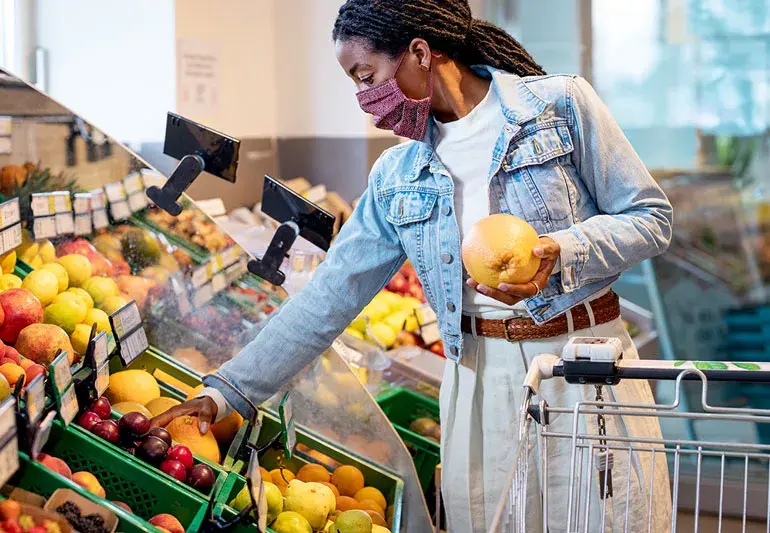Before you go shopping, make a plan for your meals
A clear plan is the key to smart food shopping. Plan your meals for the next week before you go to the store. It will only take five minutes. Make a list of the foods you’ll need for breakfast, lunch, dinner, and snacks. To stay on budget and make sure you get the right mix of nutrients, make a meal plan before you go shopping. It also prevents you from having to order takeout or junk food when you don’t know what to make for dinner.
Look around the outside of the store
Most shopping shops are set up so that people walk quickly through rows of prepared and packed foods. Instead, focus on the edges, where you’ll find fresh food, meat, cheese, and whole grains. In front of the door, fruits and veggies set a good mood for your trip. On the other side of the store are the lean meats, like chicken breasts, fish, tofu, and beans. The bread or bulk grains area is usually in the back. You can naturally stay away from sugary snacks, salty chips, and highly processed foods if you don’t spend too much time in the middle areas.
Don’t make any changes to a written list
After planning your meals and creating a list, it’s important to adhere to it. A written list helps buyers spend less and avoid buying things that are bad for them, according to research. Check things off as you go with your phone or a small notepad. Check to see if something that looks good but isn’t on your list really fits with your meal plan and health goals. Saying “no” once helps you form better habits.
Accept frozen vegetables and fruits
It’s best to eat fresh food, but it can be pricey and goes bad quickly. Instead of fresh fruits and veggies, you can buy them frozen. We pick and quickly freeze them at their ripest, retaining all of their nutrients and taste. Berries are great for drinks, peas are great for quick sides, and mixed veggies are great for stir-fries. You can mix frozen greens like spinach and kale into eggs, stews, or soups. You can always have healthy foods on hand if you keep a stash in the freezer.
Plan how you’ll read labels
Power-shop with a goal in mind when you do go into the middle aisles. Before putting something in your cart, read the calorie labels and ingredient lists. Look for whole-food ingredients like nuts, seeds, beans, whole grains, and more. Stay away from goods that have a long list of additives that you can’t identify, too much sugar, or fats that are bad for you. If there are more than five ingredients, or if sugar, corn syrup, or hydrogenated oil are in the first few, it’s probably not worth buying.
Carefully Buy in Bulk
When you buy big amounts of spices, nuts, seeds, whole grains, and beans, you can save money. Bring containers that you can use again or use the bags that are there to get exact amounts. You can get healthy staples at a lower cost per serving when you shop in bulk. It also cuts down on packaging waste. Please ensure you have a suitable place to store these items so they remain fresh. The best way to do this is in a cool, dark closet with sealed cases.
Pick produce that is in season and close by
Fruits and veggies that are in season tend to taste better, be healthier, and cost less. You can get fresh, local food right from the grower at farmers’ markets and community-supported agriculture (CSA) programs. A lot of food shops also put special things in the spotlight. Eating with the seasons not only forces you to try new foods, but it also helps local farmers and lowers your carbon footprint.
Protein and fiber should come first
Protein and fiber help you feel full and pleased, which keeps you from eating too much later. When you go shopping, make sure that your cart is full of high-fiber foods like fruits, veggies, whole grains, legumes, lean meats, fish, eggs, beans, lentils, and Greek yogurt. These foods are the building blocks of healthy meals and snacks that keep your energy and blood sugar levels steady all day.
Do not shop when you are hungry
A common but important piece of advice is to never go food shopping when you’re hungry. When you are hungry, you are more likely to make impulsive purchases of high-calorie, low-nutrient foods. You should eat a healthy snack or meal with protein, fiber, and healthy fats before you go shopping. For example, you could eat Greek yogurt with berries or apple slices with peanut butter. You are more likely to stick to your list and not give in to the cookie aisle.
Don’t just look at sale prices; compare unit prices too
If the quality is poor or the package is small, deals that seem too good to be true may not be. You can be sure you’re getting a good deal when you compare unit prices, such as cents per ounce or pound. On the shelf tag of many items, you can find the unit price. Spices, grains, and canned goods that are bought in bulk are often cheaper per unit, but sometimes a sale price on a smaller package is better than the bulk price. You will spend wisely if you quickly look at unit prices.
Make sure your pantry is always stocked
Having a well-stocked kitchen facilitates last-minute cooking. Healthy oils, vinegar, spices, nut butters, and foods like brown rice, quinoa, oats, and canned or dried beans are all good things to have on hand. You can still make healthy meals when you don’t have any fresh ones on hand, like a bean chili, a grain bowl, or simple pasta with garlic and olive oil. Having a well-stocked pantry keeps you from reaching for quick foods.
Limit single-serve and packaged items
Single-serve things usually come in more boxes and cost more per unit. Instead, make snack bags or packages that you can use again and again at home with things like nuts, popcorn, or trail mix. This habit saves money, cuts down on waste, and helps you control your amount sizes, which helps you eat more mindfully and avoid overeating.
Plan for kitchen cleanup and cooking in bulk
When you plan your meals, you might want to make extra soups, stews, casseroles, and grains that freeze or reheat well. When you cook in bulk on the weekends, you have healthy meals ready to eat when the week gets busy. Put leftovers in separate containers, write the dates on them, and put them in the fridge or freezer. With this plan, you won’t waste as much food, save time, and order takeout when you don’t need to.
Use programs and apps that reward you for being loyalA lot of food shops have membership cards or apps that have digital coupons, custom savings, and special deals on them. It’s free to sign up, and you could save a lot of money on things you buy often. You can get more for your money at the grocery store by using these digital deals along with maker coupons and sale items.
Be able to change and adapt
With a meal plan and shopping list, things can go wrong—stores may run out of food or your taste buds may change. Please remain flexible: if you require an item but it’s unavailable or the price is too high, consider selecting a similar alternative. If the dish called for fish, get beans or salmon instead. You can stay on track with your healthy goals without feeling stressed or angry if you learn how to adapt your approach.
Take your time and learn as you go. Smart food shopping is a skill that gets better with use. You might feel like you’re going more slowly on the first few trips as you read labels and figure out unit prices, but after a while you’ll get a feel for what’s healthy, cheap, and filling. Every time you go shopping, use it as a chance to improve your habits, try new foods, and remind yourself that real, raw foods are the foundation of a healthy lifestyle.
You can use your trips to the grocery store to improve your health by planning ahead, focusing on whole foods, and using easy techniques like making lists and buying in bulk. Every time you go shopping, you’re not just adding things to your cart; you’re also investing in your health, energy, and life. Have fun shopping!




